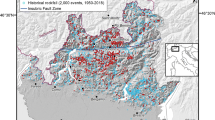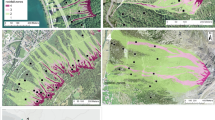Abstract
Classical rockfall simulation models do not integrate the effect of coppice forest on bocks propagation. Although field observations and experimental tests have shown that coppice forest can play an important role of protection against rockfall hazard. In order to integrate coppice forest in rockfall modeling two models will be developed. The first one will generate a virtual coppice forest stands, the other will model the impact of a block against a coppice stem. To characterize the spatial organization of coppice forest and to develop a methodology to generate virtual coppice forest stands, dendrometric data have to be collected in forest with protection function. In a second time spatial point pattern analyses have to be carried out on the collected data in order to develop a model which automatically generates coppice forest structures using key dendrometic parameters. Second, the key issues in a numerical model of a block that impacts a clump in coppice forest are the definition of a “green wood” rheology material as well as the modeling of the contact between a block and a stem under dynamic loading. These issues will be tackled using laboratory experiments and a mechanical model of impact based on the discrete element method (DEM). Finally the two modules developed in this work: virtual coppice forest stand generation and impact modeling of a rock on a coppice will be integrated and validated in a 3D rockfall model.
Access provided by Autonomous University of Puebla. Download conference paper PDF
Similar content being viewed by others
Keywords
1 Introduction
Forest can play an important role in mitigating rockfall hazard that endanger human life and facility. In the French Alps, coppice forests are largely represented and often located uphill endangered issues. Coppice forest is characterized by species that can resprout from tree stump creating a structure called clump composed of small diameter trees (<10 cm). The peculiarities of coppice forests lie both in the clustered spatial distribution of the stem and in the morphology of the clump composed of several stems. Current rockfall model can account for the mitigation effect of forest on a slope (Dorren et al. 2004). The models are calibrated using data collected in mature forest characterize by large diameter trees (Dorren and Berger 2006). However the mechanical response of a coppice structure is not yet integrated in those models. Previous studies have been done in order to characterize coppices capacity to dissipate energy after a block impact (Jancke et al. 2009; Jancke et al. 2013). For now, it remains totally unclear how coppice forests should be structured for optimizing rockfall protection. The present thesis work aims to integrate coppice forest mitigating effect in rockfall models. The first objective of the work is to characterize the spatial organization of coppice forest and to develop a methodology to generate virtual coppice forest stands. The second object is to study the mechanical response of a coppice structure under a block impact.
2 Modelling the Spatial Structure of a Coppice Forest
In order to study and model the spatial distribution of coppice forest six forest inventories have been setup in coppice forest stands, four in the French Alps between Grenoble and Alberville and two near Auzat in French Pyrenees. The main species encountered were Fagus Sylvatica, Acer Opalus, Quercus Pubescens. All stand, were located in rockfall propagation zones. 2,500 m2 rectangular inventories were established in homogeneous parts of every stand. Analysis of the spatial point pattern requires detailed information on individual stems. For each plot all standing stems with a diameter measured at breast height (DBH 1.3 m) larger than 5 cm were recorded. Tree species, DBH, and absolute X and Y coordinates of each stem were recorded using an ultrasound distance measuring device. In addition the number of stem per stools and the phytosanitary state of the stem were recorded.
The spatial distribution of the stems for the different plot was analyzed using spatial points pattern function : Ripley K function K(r), L function L(r), the pair density function g(r), and the second order neighbor density function n(r) (kfun in ads package of R (Pélissier and Goreaud 2001)).
Results shown in Fig. 348.2 were calculated on a coppice stand located in Gresy sur Isere Fig. 348.1 using Ripley K function and it’s derivate. Edge effects were corrected using the kfun of ads package (Ripley 1977). The null hypothesis of spatial randomness is represented by the green curve, a confidence envelope of 99 % was also simulated using Monte-Carlo methods (Besag and Diggle 1977).
The results from the analysis of the six stands show a significant clustering effect associated with a higher stem densities for distances r < 1 m around the stem. On the contrary the centroids of the stools were shown to be randomly distributed.
Future developments will consist in building a typology of the spatial structure of coppice stands and developing a model which will generate virtual stands based on this typology. The model will use Neyman-Scott and Poisson processes to generate the spatial pattern of a coppice stand and will be validated using a representative sample of coppice stands.
3 Modeling the Impact of a Block on a Clump
3.1 Impact on a Fully Embedded Stem
The mechanical response of a “green wood” stem under dynamic loading is studied using stem fully clamped to a rigid structure and impacted by a charpy pendulum Fig. 348.3. Two impacts per stem, at increasing impact energies, are performed to induce different stem dynamic responses. The first impact is performed at a low energy level in order to study the elastic behavior of the stem and to limit its damage. The influence of plasticity of the wood material in the stem response is assessed from the second high impact energy level test Fig. 348.4. Forty stems of European beach (Fagus Sylvatica) are collected from the Col de Vence forest in the Rhone Alps region (France). A high-speed camera (Photron Fastcam, Nikkon 35–80 mm lens) is placed vertically and is used to follow and record the displacement of the pendulum and the stem deformation with an acquisition speed of 1,500 fps and a resolution of 1,024 × 512 pixels. One force sensor (Siscam MC-100) placed on the charpy pendulum allowed measuring the force evolution in time at the impact point. A numerical detection program allowed automatic shape detection of 12 white marks painted along the stem for a proper detection of its deformation.
3.2 Toward Impact on a Clump
Perspective work will be the development of a numerical model of a block impacting a coppice structure using the Discrete Element Method (DEM). The multi stem structure of a coppice stand will be modeled as an assembly of cylinder and the block as a sphere. Sphere and cylinders will be modeled as locally deformable bodies and the interaction between the block and a stem or the interaction between two stems will be modeled by contact forces apply to both the block and the stems. A specific contact law will be developed and will allow calculating the interaction forces from the block-stem or stem-stem relative positions and velocities. Calibration and validation of the numerical model will be based on laboratory tests and field experiments.
4 Conclusion
In order to develop efficient forest management for coppice forests with a protection function, coppice stands have to be integrated in rockfall modeling (Jancke et al. 2013; Bertrand et al. 2013). Knowing how much energy a coppice forest can dissipate during a rockfall propagation is a key point to develop efficient forest maintenance.
The development of the two models: coppice forest generation model and numerical model of a block impacting a coppice structure will allow a good integration of coppice forests in rockfall models. The first results obtained on the analysis of the spatial structure of different coppice forests allow building the first part of the coppice forest model generation. Adapted and tested field inventories will be developed in parallel to enhance time spending on the field and the quality of the acquire data.
A numerical model will integrate the coppice structure and saplings behavior under a block impact. In order to efficiently integrate and enhance rockfall models a probabilistic adaptation of the numerical model developed will be investigated.
References
Bertrand D, Bourrier F, Olmedo I, Brun M, Berger F, Liman A (2013) Experimental and numerical dynamic analysis of a live tree stem impacted by a Charpy pendulum 1689–1698
Besag J, Diggle PJ (1977) Simple monte Carlo tests for spatial pattern. Appl Stat 26:327–333
Dorren LKA, Berger F (2006) Stem breakage of trees and energy dissipation during rockfall impacts 63–71 (2006)
Dorren LKA, Maier B, Putters US, Seijmonsbergen AC (2004) Combining field and modelling techniques to assess rockfall dynamics on a protection forest hillslope in the European Alps. Geomorphology 57:151–167
Jancke O, Dorren LKA, Berger F, Fuhr M, Köhl M (2009) Implications of coppice stand characteristics on the rockfall protection function, 259:124–131
Jancke O, Berger F, Dorren LKA (2013) Mechanical resistance of coppice stems derived from full-scale impact tests, 38:994–1003
Pélissier R, Goreaud F (2001) A practical approach to the study of spatial structure in simple cases of heterogeneous vegetation. J Veg Sci 12:99–108
Ripley BD (1977) Modeling spatial point patterns. J R Stat Soc 172–212
Author information
Authors and Affiliations
Corresponding author
Editor information
Editors and Affiliations
Rights and permissions
Copyright information
© 2015 Springer International Publishing Switzerland
About this paper
Cite this paper
Toe, D., Bourrier, F., Berger, F. (2015). Improving the Integration of Coppice Forest Protection in Rockfall Model. In: Lollino, G., et al. Engineering Geology for Society and Territory - Volume 2. Springer, Cham. https://doi.org/10.1007/978-3-319-09057-3_348
Download citation
DOI: https://doi.org/10.1007/978-3-319-09057-3_348
Published:
Publisher Name: Springer, Cham
Print ISBN: 978-3-319-09056-6
Online ISBN: 978-3-319-09057-3
eBook Packages: Earth and Environmental ScienceEarth and Environmental Science (R0)








